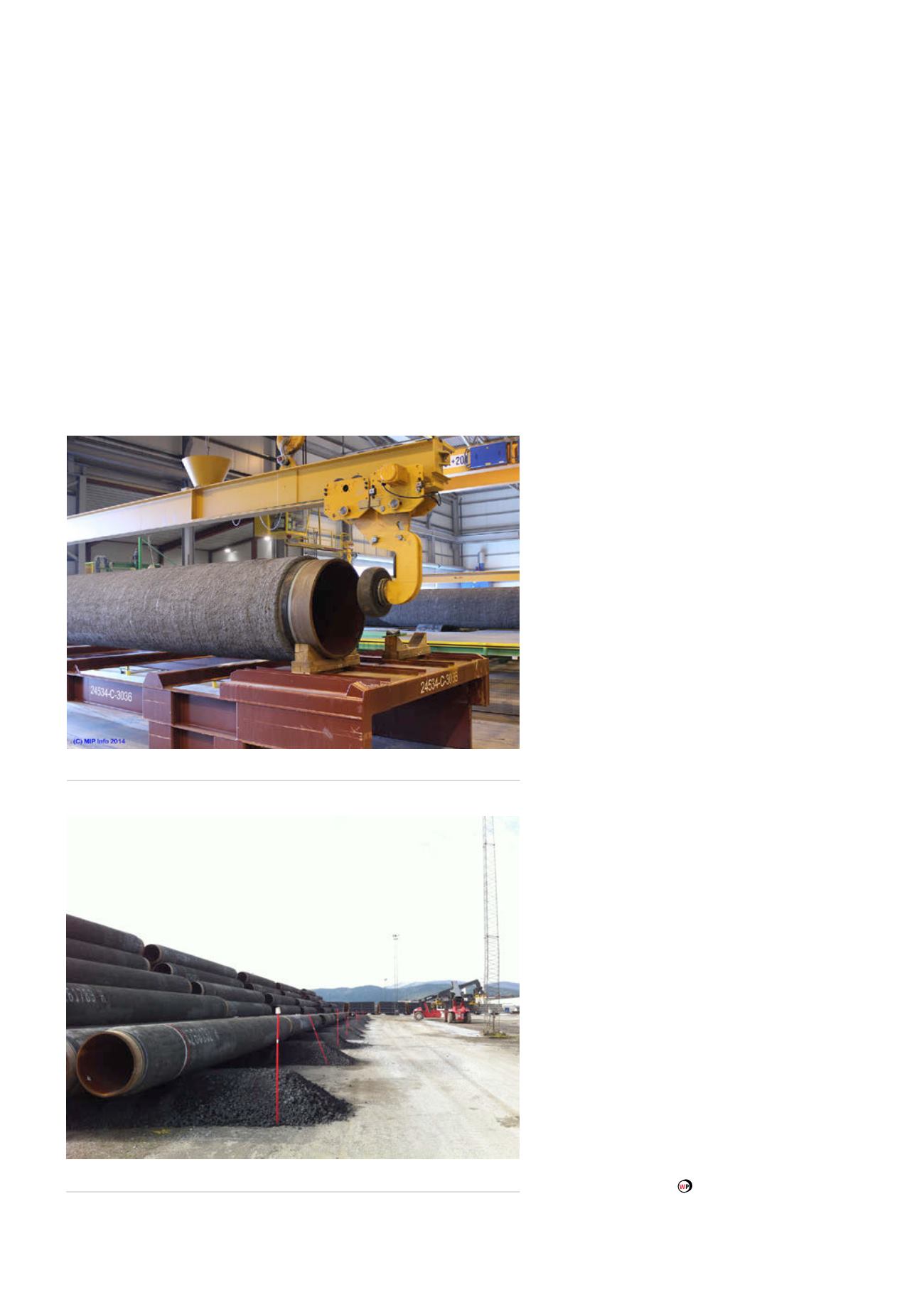
concentric with the pipe, and is the specified distance above the
pipe surface.
The caged pipe ready for concrete weight coating
application is then placed onto the coating buggies. The coating
buggies operate using a carousel system and on their circuit
pass under the concrete throwing unit. The lateral speed of the
buggies are synchronised with the rotation speed of the pipe
and the output of the application rollers to ensure the correct
thickness of concrete is applied to the pipe.
After the coating application, the buggie travels at high
speed to the end of the track and is transferred to a different
track. The coated pipe is lifted off the buggy and weighed. The
resultant negative buoyancy (NB) and density is then calculated
automatically and is checked against the specific requirements to
ensure conformance to specifications.
The QC cleared, weighed coated pipe is then be transferred
to the cleaning stations where the cutback areas are cleaned
of any concrete. Upon completion the pipe is placed on a
special custom built cassette supported only on the steel pipe
ends. This ensures the entire concrete coating is exposed to
the steam curing process. The cassette is placed into a curing
enclosure where each batch of pipes can be cured according to a
predetermined temperature profile.
Once the curing is completed the cassettes are returned
to the plant where the cured pipes are transferred to the paint
marking and QC Tally point. After the final tally, the pipe is
loaded onto trailers for transport to the storage yards. The pipes
are unloaded by a reach stacker onto prepared sand rows and
are stored until load-out.
Wasco completed the entire scope of concrete weight
coating in its Mo i Rana facility in April 2015, with
record productivity and near zero rejection rate.
To facilitate the logistic operations to
continuously feed the pipelaying barge, between
the months of October and February 2015, 20 000
concrete coated pipes weighing 250 000 t were
transhipped down south to a strategic pipe
storage location in Kristiansund ready for load out
operations in March 2015. The final pipes were
loaded out on 29 September 2015 and throughout
the project, the team performed over 1.32 million
individual pipe lifts moving a total of 13.4 million t
of coated pipes, which is definitely a logistic feat on
itself.
Best in class solutions
Wasco believes in providing the most competitive
and reliable solutions to its clients. This
includes finding innovative solutions to meet
clients’ requirement beyond just the coating
specifications.
The Polarled project is a good example. Not
only did Wasco provide a solution in managing
the cost and logistics of the coated pipes, but
the project also created a positive ripple effect
to the northern region of Norway and the
local community. At its peak, Wasco hired 300
employees at its facility in Mo i Rana. Wasco
conducted rigorous training in HSE and quality to
ensure that safety remains the number one priority
and the highest level of quality is maintained
even in its new operations. During the duration
of the project also, Wasco utilised the services of
numerous local subcontractors and suppliers, which
provides support to the local economies of the
market it operates in.
Smart partnerships become the enabler for
projects to take off successfully especially in the
current slowdown facing the industry. This has been
the business model for Wasco. The company stands
by its credo of partnership and commitment to serve
the oil and gas industry.
Figure 4.
Cured pipe from steam cure returning to plant for final inspection.
Figure 5.
Concrete weight coated pipe storage in Mo i Rana.
28
World Pipelines
/
MARCH 2016


